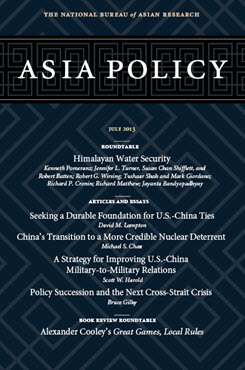Securing the Himalayas as the Water Tower of Asia
An Environmental Perspective
This is one of seven essays in the roundtable “Himalayan Water Security: The Challenges for South and Southeast Asia.”
The crucial role of mountains as the creators and providers of large volumes of freshwater and as the natural storage site of this vital ecosystem service attracted the special attention of world leaders after the United Nations Conference on Environment and Development in 1992. [1] This essay addresses the role of the Himalayas as the provider of crucial freshwater supplies to a larger number of people than any other mountain range in the world. The essay first describes the eco-hydrology of the Himalayan region, and then turns to examine the role of the Himalayan rivers in Asia’s economic and demographic growth. It concludes by analyzing the ecological imperative of sustaining the Himalayan waters.
Himalayan Waters: An Eco-hydrological Background
In terms of the number of people who depend on such “water towers” for their survival and well-being, the Himalayas are the most important. The Himalayan region, encompassing the Hindu Kush mountains and the Tibetan Plateau, spans an area of more than 4.3 million square kilometers spread across Afghanistan, Bhutan, China, India, Myanmar, Nepal, and Pakistan. The region stores more snow and ice than anywhere else in the world outside the two poles and thus is popularly known as “the third pole.” [2] Containing the highest mountains of the world, the Himalayas act as a great barrier to global atmospheric circulation. The Indian summer monsoon and the East Asian monsoon interact in this environment to provide a large portion of the water supply of Asia. Ten major rivers emerge from the Himalayan region, making it a crucial ecological buffer. These rivers include the Yellow and Yangtze, which emerge from the Qinghai Plateau and provide water to densely populated parts of the north China plain; the Mekong, Salween, and Irrawaddy, which flow southward from Tibet into Southeast Asia; the Ganges-Brahmaputra-Meghna, which drains large areas both north and south of the Himalayas and provides about two-thirds of the total annual river flow for India; and the Indus, which is the lifeline of Pakistan.
The scale of the ecosystem services that the Himalayas provide is almost without parallel in human history. The Himalayan river basins are home to about 1.3 billion people and supply water, food, and energy to more than 3 billion people. [3] Human intervention in the flow of these rivers must be based on adequate knowledge of three vital constituents of the Himalayan rivers—water flow, sediment load, and energy potential.
Since a large amount of the precipitation in the high mountain areas is stored in snow cover and glaciers, there are natural delays in the outflow of the melt water. In this way the Himalayan rivers provide crucial water supplies during dry periods. While the importance of high sediment loads in the eco-hydrology of the Himalayan rivers is well-known, knowledge of the amount of sediment carried and its role in the rivers’ morphological dynamics is still at a rudimentary stage. Despite early research on the geological denudation of the Himalayas and the expansion of the Bengal deep-sea fan at the end of the Ganges-Brahmaputra-Meghna Basin, [4] accurate information on the generation, transportation, and final deposition of sediment from the Himalayas is difficult to find. In addition, only recently have attempts been undertaken to quantify the amounts of water produced by the Himalayas. Bodo Bookhagen and Douglas Burbank have developed a hydrological budget and established an important correlation between precipitation and run-off in 27 Himalayan rivers of South Asia, starting from the Yarlung Tsangpo in the east to the Indus in the west. [5] The relative contributions of rainfall, snow melt, and glacier melt—the three factors that constitute the river flows—vary significantly from the eastern extreme of the Himalayas to the western. For example, Yarlung Tsangpo in the eastern part of the region receives about 34% of its flow from snow and glacier melt, while the Indus in the west depends on melt for 66% of its flow…
[1] For further discussion of the role of mountains as the “water towers of the world” in the global freshwater supply, see Jayanta Bandyopadhyay, “Water Towers of the World,” People and the Planet: People and Mountains, Pinnacles of Diversity 5, no. 1 (1996), http://lib.icimod.org/record/9992/files/297.pdf.
[3] Joseph R. Curray and David G. Moore, “Growth of the Bengal Deep-Sea Fan and Denudation in the Himalayas,” Geological Society of America Bulletin 82, no. 3 (1971): 563-72.
[4] Joseph R. Curray and David G. Moore, “Growth of the Bengal Deep-Sea Fan and Denudation in the Himalayas,” Geological Society of America Bulletin 82, no. 3 (1971): 563-72.
[5] Bodo Bookhagen and Douglas W. Burbank, “Towards a Complete Himalayan Hydrological Budget: Spatiotemporal Distribution of Snowmelt and Rainfall and Their Impact on River Discharge,” Journal of Geophysical Research: Earth Surface 115, no. F3 (2010).
About Asia Policy
Asia Policy is a peer-reviewed scholarly journal presenting policy-relevant academic research on the Asia-Pacific that draws clear and concise conclusions useful to today’s policymakers. Asia Policy is published quarterly in January, April, July, and October and accepts submissions on a rolling basis. Learn more


